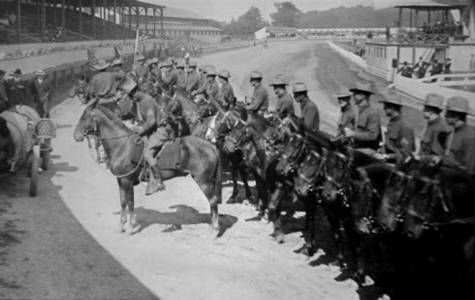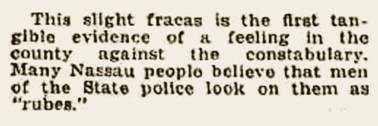Advent of the State Police
In the years leading up to 1917, Albany had become persuaded - ironically, because of a high-visibility crime in Westchester - that the state's rural counties and towns were not providing adequate policing, especially to those who lived in growing communities.
Had policing been deficient in Hicksville? Not by the prevailing local standards. The village had hired its own constables; if needed, it could call upon the Town's local Reserve Deputies; its Court House did not seem overly neglected. Local newspapers suggested that the police had the habit of overlooking unlicensed dogs, and children riding horseback in town after dark, but these were offenses about which few villagers cared. The local constabulary also rarely enforced the state-imposed 11:00 PM curfew for establishments that served liquor - a failure which many people in Hicksville happily applauded.

Some of the first New York State Police Troopers
https://centennial.troopers.ny.gov/photos/fairs-over-the-past-100-years-in-troop-a
Regardless of whether communities in New York liked or disliked the idea of getting an additional layer of policing in their streets, as soon as the new police (called "Troopers" by their founder) were fully trained, 232 mounted officers were deployed in rural areas across the state. New York was divided into State Police regions; within each region were multiple detachments. Although Nassau County announced that the local detachment eventually would be based in Mineola, it first was housed at Hicksville's Grand Central Hotel.
In some - in many - communities, the Troopers were resented by local law enforcement. Rumors were circulated, most of them likely false; some depicted the new police as arrogant. It did not help that the Troopers had been ordered to wear their holstered firearms outside their uniform - a practice almost unheard of then, and one which suggested swagger to the average citizen. Locals were told that "the Troopers had been kicked out" of the village of Glen Cove (not true), and that Hicksville should do the same. Citizens' trust in the State Police was not bolstered when a Mineola physician testified in court that while he was driving home one night, a Trooper shot at his tires - to stop him because his car's tail light was not lit.
Troopers and the townspeople were at odds at the beginning, and everyone admitted it. The official online State Police history notes that
"One of the earliest challenges facing the Troopers was to overcome the natural suspicions of the rural population they were sent out to protect. Many rural newspapers voiced the common belief that the force was unneeded and an unnecessary expense."
https://www.troopers.ny.gov/Introduction/History/1917-1929/
The Brooklyn Daily Eagle wrote that the riot in Hicksville was indicative of feelings in much of the County:

Thus, Hicksville had a second reason to be polarized. Suspicion and resentment were near the surface of any confrontation between State Troopers (and their supporters) and those citizens who favored the old status quo.
***

